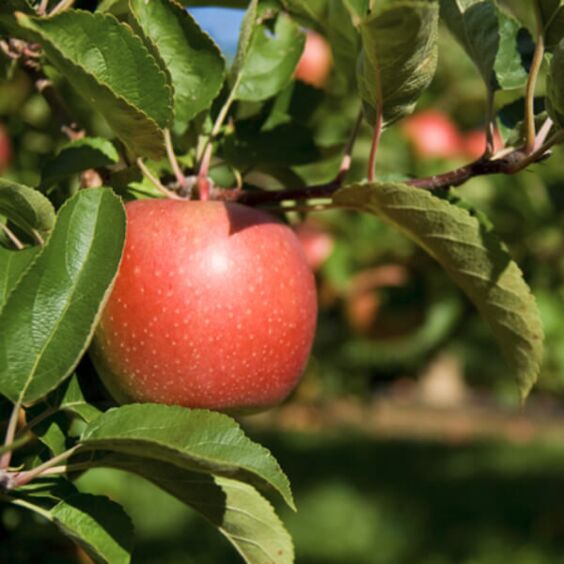
Growing zones
See Zone Map >Status: Out of stock
- Sun
Mature Plant Size (H x W): 12-15' x 12-15'
Bloom Season: Spring
- Attracts Bees
- Attracts Birds
- Edible to People
- Attracts Butterflies
- Attracts Pollinators
Planting & Care for Edible Plants - Semi-Dwarf Cortland Apple Trees
Preparation
- Apple trees need well-drained soil that’s not too wet. They like soils that are moderately rich and retain moisture as well as air. Use mulch combined with straw, hay, or some other organic material to keep soil moist and provide nutrients as they decompose.
- Be sure to choose a sunny site. For best fruiting, an apple tree needs “full sunlight,” (6-8 hours of direct summer sun daily). The best exposure for apples is a north or east facing areas.
- Spring planting is recommended in central and northern areas for the Semi-Dwarf Cortland Apple Tree. Where fall and winter weather is generally mild and moist, fall planting is successful.
- Proper spacing for each size tree is important. Semi dwarf – 12-15’ of space, dwarf – 8-10’ spacing, and standard apple trees 30-35’ of space.
- Dwarf varieties will need some type of support to grow.
Opening Plant Material
- Bare Root - Cut open the bundle (top and roots are tied) and separate all the plants. Soak roots in buckets of water until planted (soak for at least 24 hours). Each plant type will be labeled separately for identification. Do not expose the roots to sun. They should never dry out. Keep roots covered. All bare root plants must be trimmed when planted. Be aware that when you receive your plant it’s in a state of dormancy and will look very bare, this is normal.
Planting Bare Root
- Dig a hole at least 6"" wider and the same depth as the root mass. The crown or graft of the plant should be slightly higher than ground level where it was grown at the nursery.
- Trim off the broken roots and branches.
- Do not use any fertilizer packets as this many “burn” your plant.
- Spread the roots and fill halfway with soil, then water until soil settles completely saturating the soil and planting pit.
- Re-adjust plant and fill the hole with the rest of the soil.
- Back-fill the balance of the soil and water well.
- Scroll to the bottom and click on the orange rectangular box “Handling & Plant Guidelines” to see an illustration on planting bare root plants.
Pruning – After planting (young tree)
- Be sure not to heavily prune your plant too soon. Follow the instruction below for how to prune right away.
- Prune and remove any broken or damaged branches or roots from shipment.
- Remove branches that may be too low. This will also help promote faster top growth.
- Additional pruning to help in transplanting can be achieved by selectively removing branches that are too close or otherwise might not be proportionate with the rest of the tree.
Planting & Handling Help
Download our Planting and Handling Guide below to plan for a successful arrival and install of your plants. Be sure to water all plants as soon as they arrive and every day until you’re ready to plant. Keep any bare root bundles in a shady, cool spot with the roots covered at all times.


Learn More
Watch our videos on handling bare root plants, how your order is prepared for shipment and more.


Plant Sizing
What is the difference between Containers, Grow Bags, Bare Root, and Balled & Burlap (B&B)?
Shipping Times


Our FedEx and local shipping times depend on two factors, one is by the region and the second is the type of product being shipped. For example, small fruits are only shipped in spring, but majority of our perennials are shipped from spring until fall. Keep in mind the dates below act as a general guide. Due to unpredictable weather, staffing, inventory and industry demands these timelines can change. Therefore, we cannot guarantee any of these times.
Shipping Dates by Region*
Northern Cold Region: April 22nd - November 7th
Northern Region: April 15th - November 7th
Middle Region: April 1st - November 7th
Southern Region: March 15th - November 7th
Local Delivery (small radius from Waterloo, WI): April 22nd - November 7th
Shipping Dates by Season*
Spring Shipping: Region Start Date (above) - May
Fall Shipping: September - November
Due to unpredictable weather, these times may vary. Some varieties are exceptions due to heat and plant health reasons. Enter your shipping zip code at the top of this page and be sure to check the shipping information on each product before you add it to your cart. If the product is too large or restricted in your state, you will not be able to checkout with that item in your cart.
